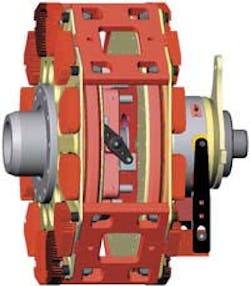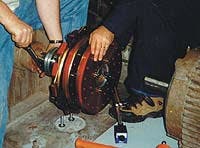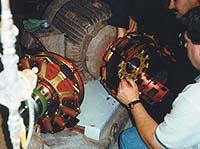New Magnetic Drives Solve Pump Vibration Problems
By Ken Black
The Rock Creek Facility of Clean Water Services in Hillsboro, OR, serves over 150,000 residents and industries, providing advanced levels of wastewater treatment never before achieved in the state.
Yet despite its national reputation for innovation and impeccable management, the Rock Creek plant had maintenance issues in some of its processes that reduced the efficiency of its pumping systems and incurred tremendous repair costs.
The main problem involved torque pulses from pumping systems used to transfer digester biosolids to belt presses. At high volume, the single vane pump impellers generated torque pulses in the downstream piping, creating constant vibration and requiring continual repair and replacement.
Initial attempts to tackle the problem involved running the pumps at reduced speeds through Variable Frequency Drives (VFDs). The drives reduced vibration marginally, but did not solve the shaking problem. In addition, a bypass valve was kept constantly open to help reduce pressure and protect system piping, although the managers knew this energy-wasting fix was not a long-term solution.
Enter MagnaDrive, a Seattle-based company that manufactures magnetic adjustable speed drives (ASDs) for commercial, industrial and municipal facilities. The MagnaDrive ASD uses powerful magnets to transfer torque and enable "soft" starts, decreasing energy spikes and vibration, while increasing motor life.
The magnetic adjustable speed drive consists of a magnet rotor assembly with an array of rare-earth permanent magnets on the load side, and a copper conductor assembly that connects to the motor. There is an air gap between the two components so they never have contact. Relative motion between the magnets and the copper creates a strong magnetic field that transmits torque across the air gap. The magnetic "pull" between the magnets and the copper creates a coupling force. Varying the width of the air gap changes the coupling force, so the amount of torque transferred between the motor and load, and therefore the output speed, can be continuously and precisely adjusted.
When fully engaged, the drive can function at 98 percent efficiency of a direct connection. And because there is no physical connection between motor and load, vibration is eliminated, greatly reducing wear and tear, equipment and facility damage, and overall maintenance costs.
At the Rock Creek facility, a MagnaDrive ASD was installed on one of two 60 hp motors and pumps supplying digester biosolids to four belt presses where they are pressed and de-watered. The system was previously controlled with variable frequency drives. Surprised engineers and operators watched as all four presses were brought online with only one pump, negating the need for a second pumping system and the associated equipment and space. Vibration and shaking experienced with the VFD-controlled system were eliminated.
Energy audit data showed less than 10 hp needed to supply full flow to four presses, allowing the motor and the MagnaDrive ASD to be subsequently downsized from 60 hp at 1800 rpm to 20 hp at 1200 rpm. This reduced energy demand from 9.6 kW draw for two 60 hp motors running on VFDs, to 5.5 kW draw for one 20 hp motor running the pump through the MagnaDrive ASD - a reduction of nearly 28 percent. In addition, closing the bypass valve that had been continually open demonstrated an additional 23 percent decrease in energy use.
Over time, the magnetic ASD significantly reduced maintenance and replacement costs and avoided the commonly cited problems of VFDs, including harmonics, noise, heat and space limitations. The motor size reduction was another key benefit, as engineers were given the freedom to control the load with a motor sized for running - rather than start-up. WW/
About the Author: Ken Black, PE, is Senior Applications Engineer for MagnaDrive Corporation. To learn more about this new technology, contact Black at 206.694.4731




